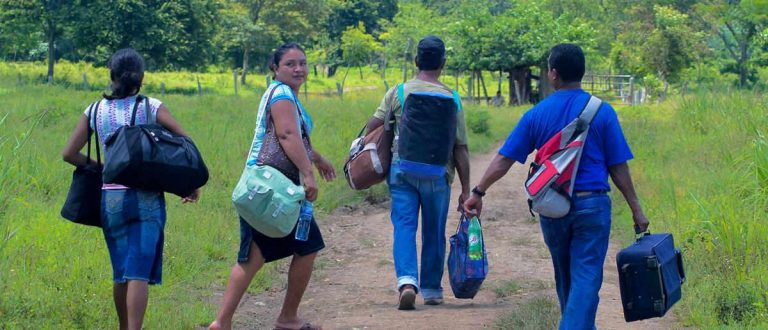
New Biden administration measures may make it easier to apply for asylum.
Nicaragua migration north had been very low for 14 years, always under 1,000 border encounters per month. This is especially low when compared to border encounters with people from the Northern Triangle nations of Guatemala, El Salvador and Honduras.
But in March 2021, eight months before the Nicaraguan presidential elections, an increase in migration north began. This trend reached its height in December 2022 (35,488) but, in January 2023, fell precipitously (by almost 90%) to 3,789 border encounters. The most recent number, from March 2023, showed 5,342 border encounters.
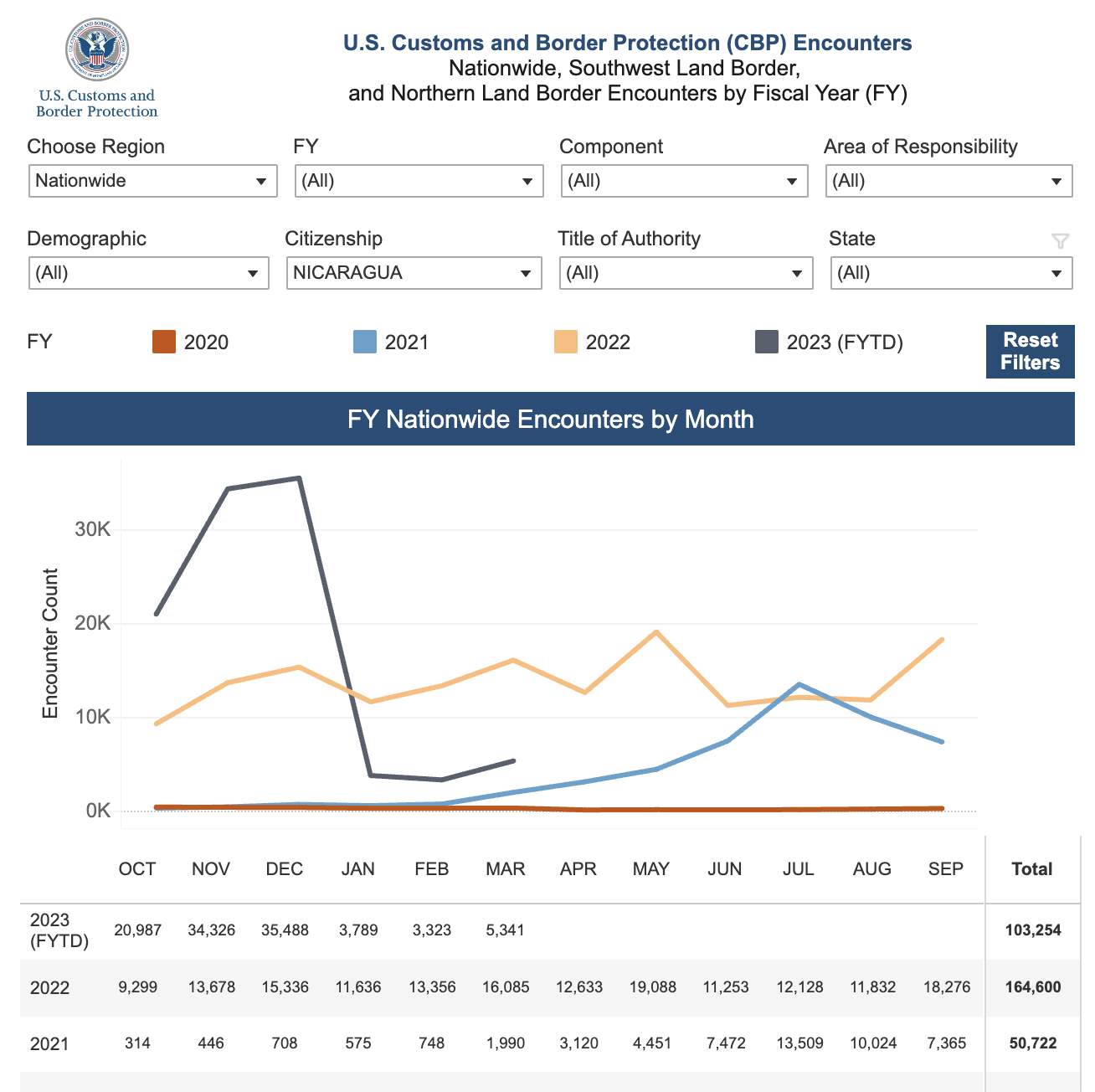
Why the increase in Nicaraguans migrating north after 14 years of it remaining low?
The Sandinista party won back the Nicaraguan presidency in January 2007 with a focus on poverty reduction, free education and health care. From that time through March 2021 there was only a trickle of migrants to the U.S.—an average of about 300 a month. But that began to change in 2021 when Nicaraguans who crossed into the U.S. and were encountered by border officials were not expelled, instead being given help with transportation to get to their final destinations.
In February 2021 many journalists began to hear what Nicaraguan migrants were telling family and friends, that once they crossed into the U.S., they should just find a border official and that official would likely help them with transportation getting to the home of family or friends so that they could work. The other news that traveled like wildfire was that there were jobs available and with pretty good wages (US$14 to $18 an hour). With these stories and, despite great advances in well-being in Nicaragua, the dream of migrating north spread like a virus.
From Nicaragua’s population of 6.6 million, more than 163,876 Nicaraguans were “encountered” at the U.S. border in FY2022 (September 30, 2021, to September 30, 2022)—70 times more than those who entered during the same period in 2020—just 2,291, according to U.S. Customs and Border Protection data. In FY 2021 there were 50,109. In the first three months of FY 2023 (October, November and December 2022) there were 90,553.
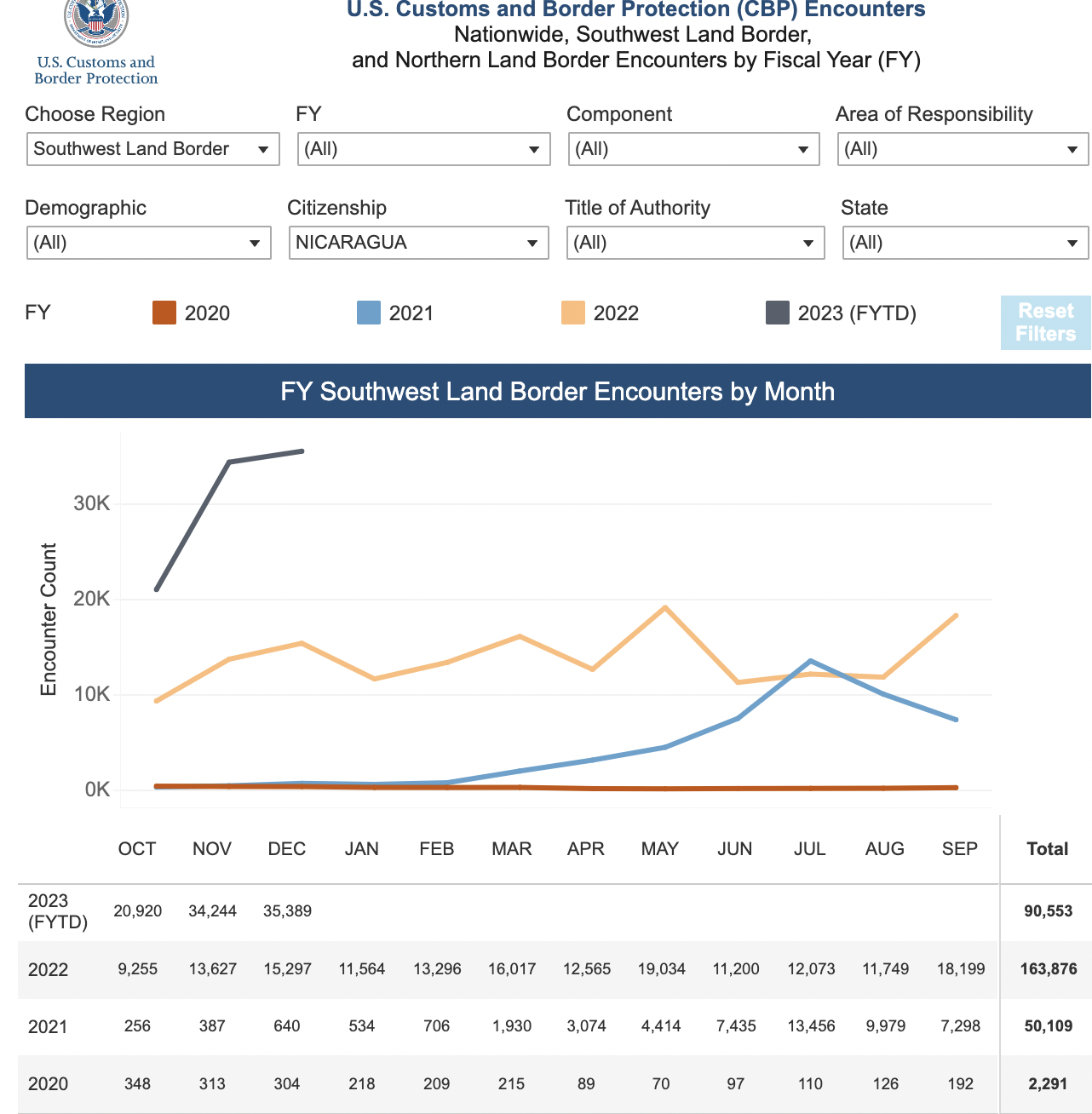
The Biden and Trump administrations spent more than half a billion dollars since 2017 in Nicaragua destabilization efforts in hopes of overthrowing the Sandinistas, who had been targeted by the U.S. since 1979 when the people overthrew dictator Anastasio Somoza—a faithful ally of the U.S. who took good care of U.S. investors and oligarchs but kept the rest of the population in poverty.
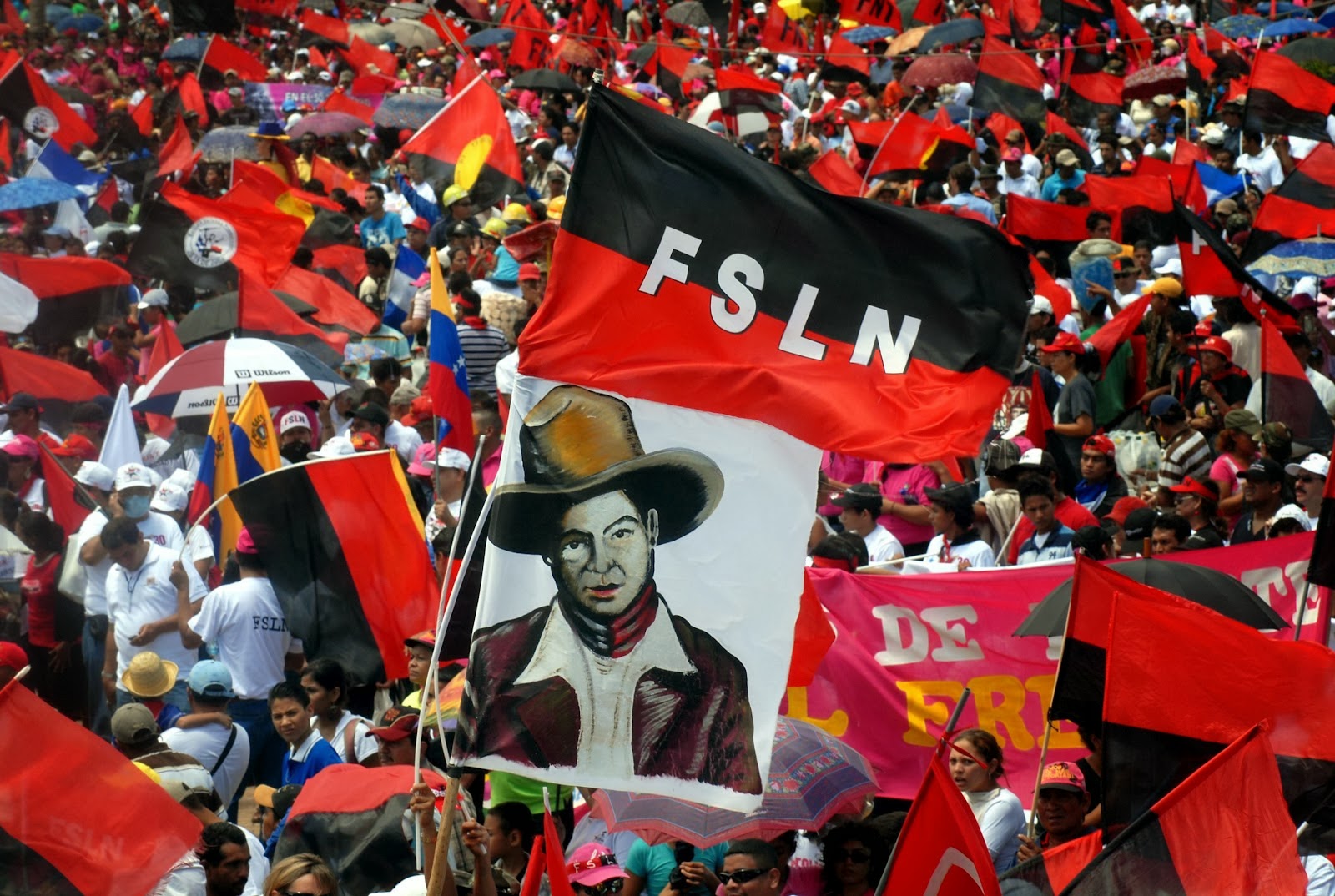
U.S. subversion efforts culminated in a failed U.S.-orchestrated coup attempt in 2018.
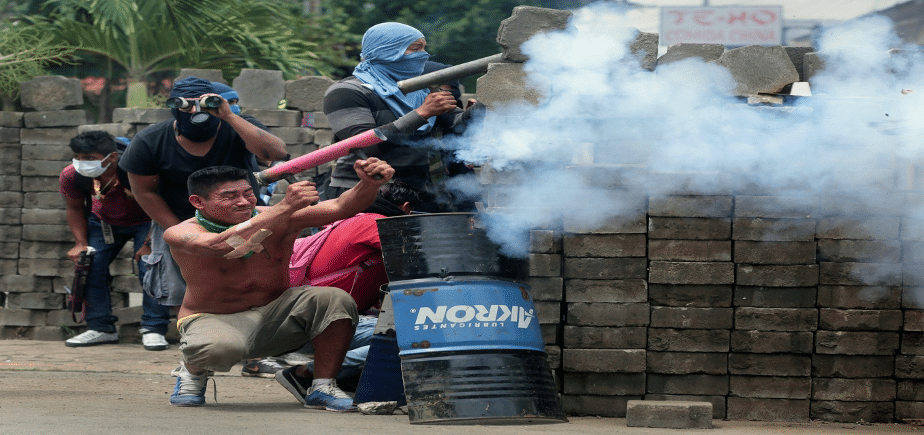
U.S.-imposed sanctions in 2018 and 2021 are one way the U.S. has turned the screws on Nicaragua’s economy in an attempt to punish the people for continuously supporting the Sandinistas.
Many other mechanisms they utilize require hundreds of millions of dollars.
As more U.S. citizens become aware of the socio-economic progress, like free universal health care and education, the best social infrastructure and roads in the region, greatly improved gender equity (ranked no. 7 world-wide), low maternal and child mortality, 90% food sovereignty, and 99.3% electricity coverage mainly with renewable energy, U.S. taxpayers may find they do not want their money being spent to try to undermine the Sandinistas.
Rather, they may want to see U.S. elected representatives emulating many of their policies.
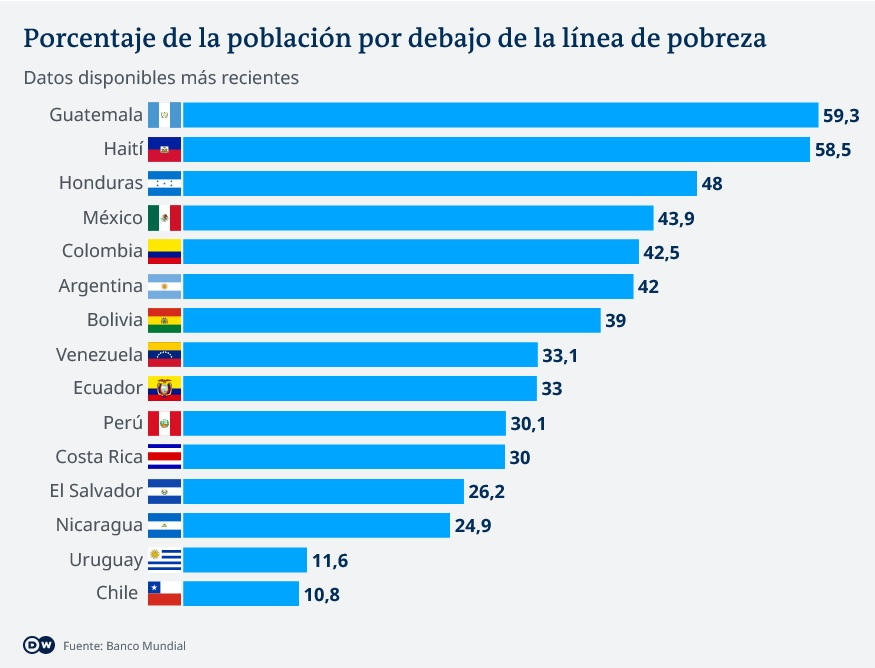

The Biden administration and the corporate media have tried to convince the U.S. public that the Nicaraguan government is an “unusual and extraordinary threat” to national security and part of what they call “the troika of tyranny”—along with two other maligned countries—Cuba and Venezuela.
But in Nicaragua’s case this narrative did not jibe with the fact that people were not leaving, especially when citizens of neighboring Honduras, El Salvador and Guatemala have migrated in droves for the last 14 years or more.
Thus, the uptick in Nicaraguan migration in 2021 and 2022 allows the U.S. government and media to assert that “people are fleeing repression!” and constitutionally elected President Daniel Ortega “is a dictator.”
U.S. Border Patrol agents apprehended a record 2.2 million migrants at the southwest border in the 2022 fiscal year ending September 30. Close to half were rapidly expelled under Title 42, which ended on May 11. More than 2.7 million migrants were expelled to Mexico or their home nations under Title 42, which allowed border guards to rapidly expel migrants with no possibility of requesting asylum.
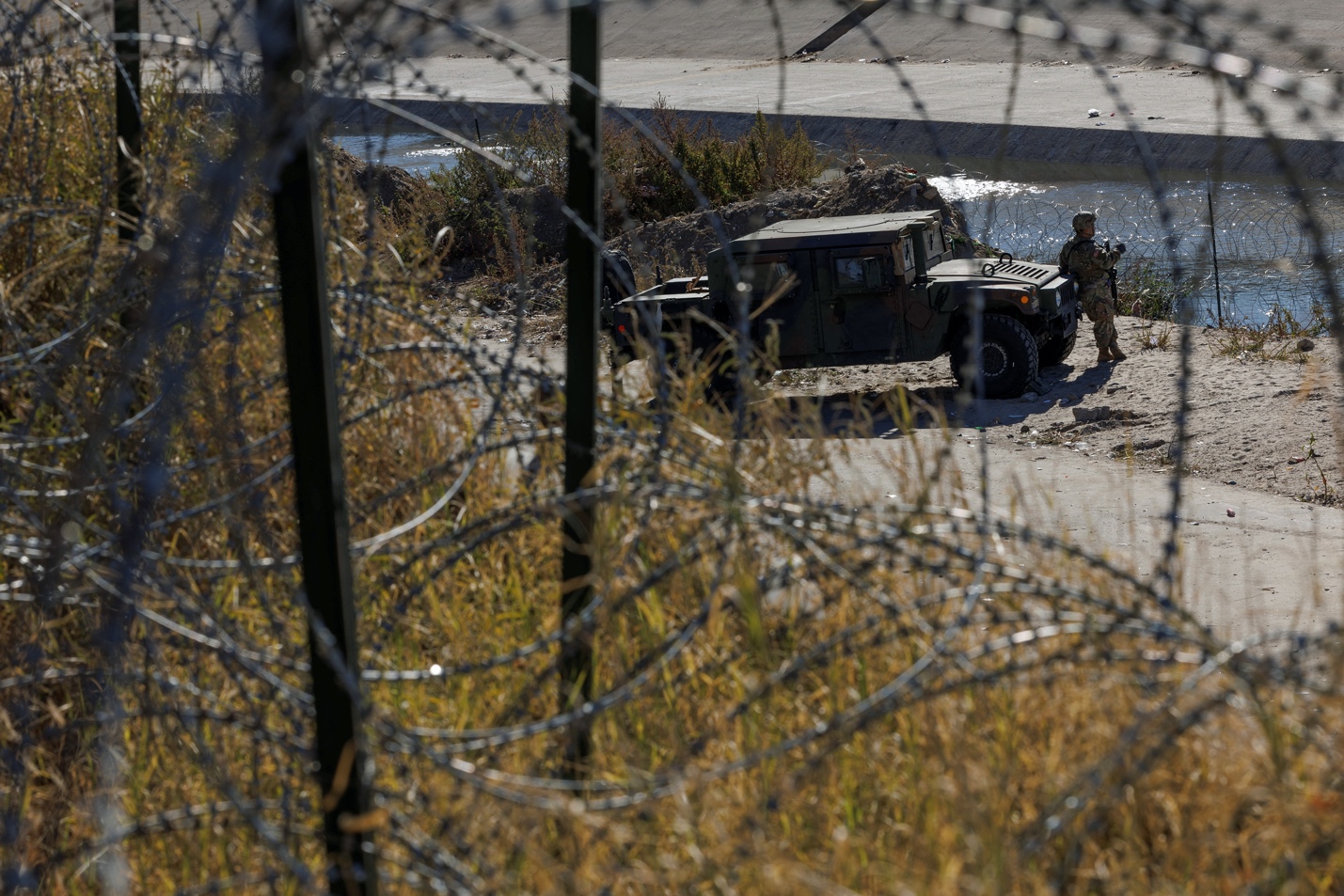
The media do not tell you that the U.S. puts pop-up advertisements on Nicaraguans’ Facebook and Instagram accounts every day about good jobs in the U.S., or that Nicaraguans are treated much better when they cross the border than their Central American brothers and sisters.
With the increase in Nicaraguan migrants it was easier for the U.S. to blame migration on the Nicaraguan government. However, from 2007 through 2020, all under the Sandinista government, a negligible number of Nicaraguans went north, a drop in the bucket compared to the high numbers of migrants from Guatemala, Honduras and El Salvador.
So it makes no sense that the Sandinista government was the reason that people migrated in record numbers from 2021 to 2022, especially since every aspect of life has improved in Nicaragua yearly from 2007 to April 2018 and again from late 2020 to date. The break in that trend was due to the U.S.-directed coup attempt in 2018, the pandemic and two hurricanes.
The New York Times in December wrote that Nicaraguans were leaving because of violence. Nicaragua is the safest country in Central America and one of the safest in Latin America and the Caribbean. It has about one-eighth the rate of murders as Honduras, and about one-fourth that of El Salvador and Guatemala. Nicaragua is the number one country in the world for percentage of population who say they always feel at peace—some 73%!
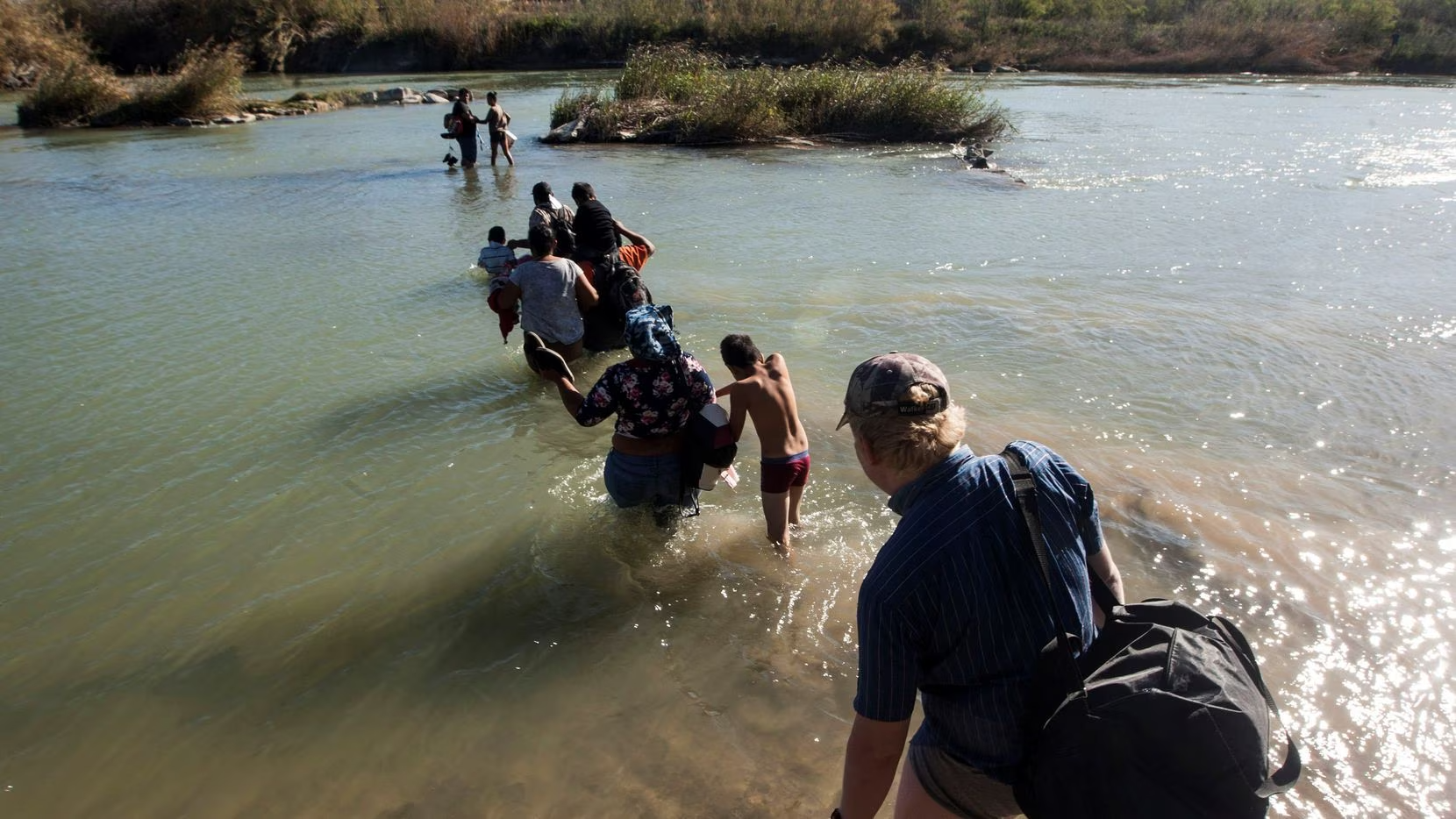
In September 2021 Joe Biden said that “it is not rational” to deport to Nicaragua, Cuba and Venezuela migrants arriving from those countries: “I am now mindful of Venezuela, Cuba and Nicaragua. The possibility of sending them back to those countries is not rational.”
Illegal U.S. sanctions have limited multilateral loans, especially from the World Bank and the Inter-American Development Bank. The World Bank did not provide loans between March 2018 and November 2020. The sanctions have spurred migration—supposedly something the U.S. does not want—so, according to Tom Ricker in a 2022 analysis of migration from Nicaragua, the sanctions have backfired, leading to more migration north.
For at least 40 years many Nicaraguans worked all or part of the year in Costa Rica, many gaining legal status. But Costa Rica’s economy was hurt by Covid and fewer jobs in that country resulted in more people returning to Nicaragua than going to Costa Rica in 2020 and 2021. In 2021, more than 5,000 more Nicaraguans left Costa Rica than entered it. Lack of jobs in Costa Rica, for those who have historically worked there, was one of the reasons for more migration north to the United States.
Other pull factors are the U.S. labor shortage and the fact that Nicaraguans were largely exempt from Title 42 at the U.S. border. If people can successfully cross the border, the border guards help them get to their destination, they likely find work and, compared to their home countries, good paying work which allows them to send money home. Other pull factors are U.S. companies advertising jobs on social media to Nicaraguans.
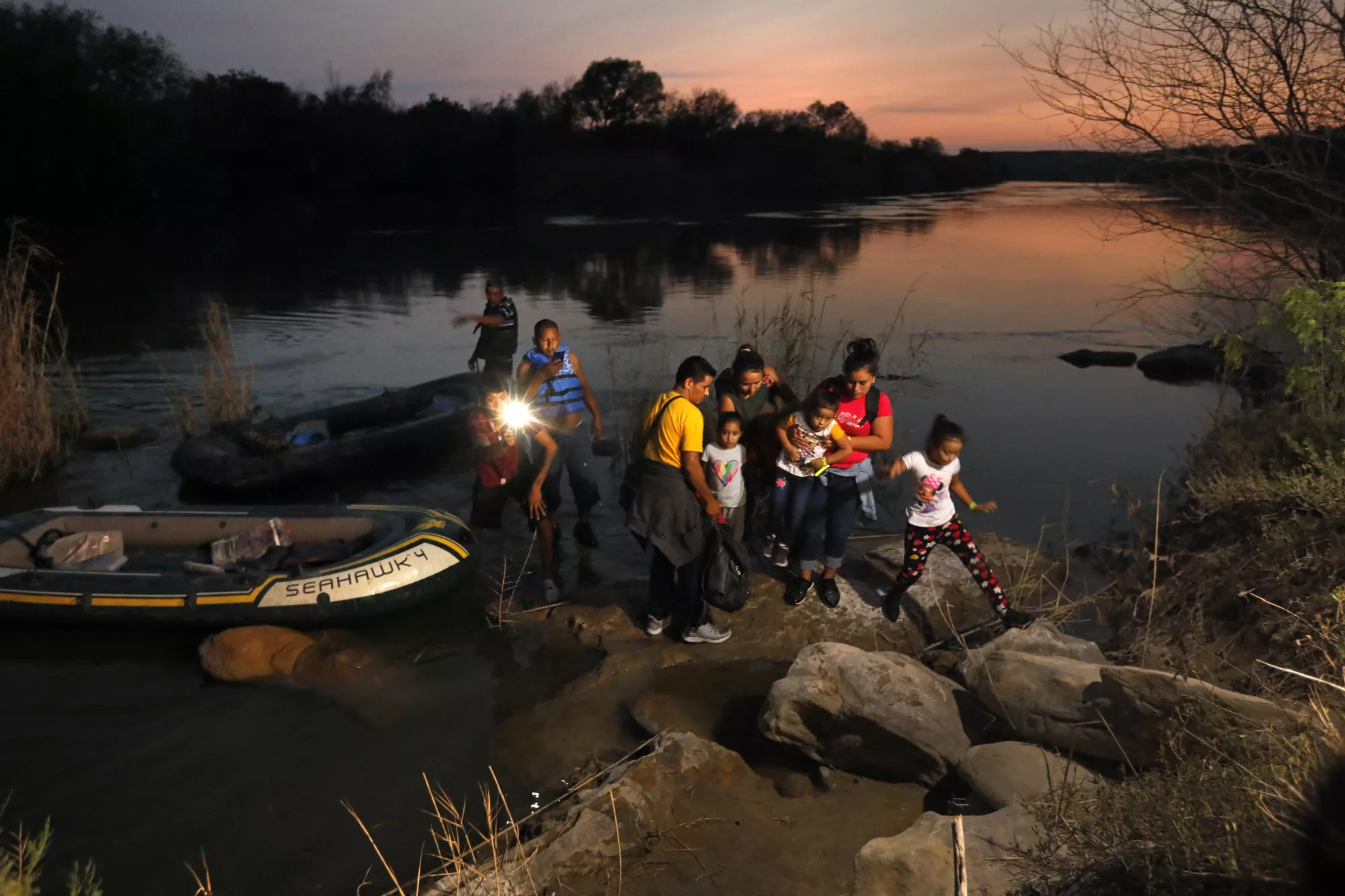
Factors that contribute to migration from Mexico and Central America
It is uncertain how many people are migrating to the U.S. from Central America. But the Migration Policy Institute says that, of the 3.4 million Central Americans living in the U.S., about 85% of them are from El Salvador, Guatemala, and Honduras. According to U.S. Customs and Border Protection, in 2020 as the pandemic slowed world-wide migration, some 450,000 people arrived at the southern border. In 2021 the number nearly quadrupled to 1.7 million migrants who were expelled or detained in the U.S. or in Mexico.
According to the U.S. Chamber of Commerce, there are currently more than 10 million job openings in the U.S. and only 5.7 million unemployed. In Minnesota there are only 43 workers for every 100 job openings. I know eleven undocumented Nicaraguan migrants working in Minnesota for pretty decent wages. All these migrants had received the message to look for a border official after crossing over; and now they are working in the U.S. under Title 8. At every hearing they are given more time to stay in the U.S. without a final decision about their status.
About one-fourth of all migrants living in the U.S., some 11 million, are undocumented and 55% of those are from Mexico. The number peaked in 2007 and has since dropped slightly. The highest increase was from 1994 to 2000 with the signing of NAFTA which destroyed an entire sector of Mexican agriculture.
The U.S. Department of Labor’s National Agricultural Workers Survey (NAWS) estimated that, of the 1.8 million U.S. agricultural workers, 70% were born in Mexico and that 70% of foreign-born crop workers are undocumented. So at least half of U.S. crop workers are undocumented. U.S. agriculture employs a higher percentage of undocumented workers than any other industry in part because pay in this sector is lower than in other sectors. There is clearly a need for migrant labor, especially in agriculture.
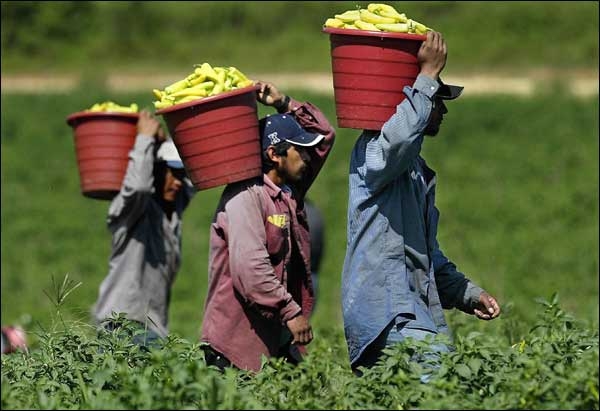
Biden’s latest immigration plans: brain drain and deportation
The new U.S. plan for Nicaragua, Venezuela, Cuba and Haiti, known as CBP One Parole (by cell-phone application), is “brain drain,” and will benefit those who are better off, more educated and not currently in the U.S. under Title 8. On January 5, 2023, the Biden administration announced this new legal pathway to what is a “Parole Process” for people from those four nations. Up to 30,000 individuals could be accepted per month. They need a valid passport, ability to pay their own airfare, pass vetting and background checks and have a documented sponsor who can provide financial and other support. Upon acceptance they get two years and receive work authorization.
During January 2023 11,637 Nicaraguans, Venezuelans, Haitians and Cubans were paroled into the country by the Office of Field Operations through the parole processes established for Venezuelans in October and expanded to the other nationalities in January 2023. In February 22,755 people from these four countries received parole through the CBP One parole process.
On April 27, 2023, the Biden administration announced new immigration measures that include opening processing centers in Guatemala and Colombia which will allow migrants who they determine to be “qualifying,” to enter the U.S., Canada or Spain legally. The U.S. signed onto the Los Angeles Declaration in 2022 with Canada and Spain, under which the U.S. agreed to resettle 20,000 refugees over the next two fiscal years.
The U.S. administration also announced a new family unification program for citizens of El Salvador, Guatemala, Honduras and Colombia where the application is also through a phone app with background checks and case-by-case eligibility. Previously this process was available to Cubans and Haitians. The CBP One app process will also be available to migrants waiting in Mexico to apply for asylum—740 applications a day will be processed on the southern border.

But the April 27 Homeland Security statement as well as the January 5 White House statement emphasize that there will be “new consequences for individuals who attempt to enter unlawfully, increasing the use of expedited removal.” Individuals who irregularly cross the Panama, Mexico or U.S. border after January 5, 2023, will be subject to expulsion.
Why did Nicaraguan migration plummet more than 99% in February?
The January 5th news of the new CBP One parole pathway mainly benefitting more-educated middle-class Nicaraguans may have had an immediate effect on people who were considering migration. Those with possibilities are applying through the parole pathway. Few poorer Nicaraguans can use this pathway—they may not have a smart phone or a person to be their financial guarantor in the U.S. Most of the migrants over the last few years are from the dryer, poorer countryside where their earnings are low.
Hundreds of thousands of Nicaraguans who previously worked part of the year in Costa Rica may be trying their luck again there with Covid-19 down and tourism up.
Some Nicaraguans considering undocumented migration may have been scared off by announcements that deportations will increase.
But what about all those unfilled jobs in the U.S., especially in the agricultural sector where Nicaraguans and others are picking up the slack? And what about the U.S. administration’s claims that people are leaving Nicaragua due to repression?
Nicaraguans who cannot take advantage of the cell-phone app may go to the new processing center soon to open in Guatemala. And it is quite possible that, despite the new measures, Nicaraguans will continue to be treated better at the border than their Northern Triangle neighbors and also allowed to stay longer in the U.S. until a final decision is made on their cases. However, eventually, it is probable that most will be deported.

CovertAction Magazine is made possible by subscriptions, orders and donations from readers like you.
Blow the Whistle on U.S. Imperialism
Click the whistle and donate
When you donate to CovertAction Magazine, you are supporting investigative journalism. Your contributions go directly to supporting the development, production, editing, and dissemination of the Magazine.
CovertAction Magazine does not receive corporate or government sponsorship. Yet, we hold a steadfast commitment to providing compensation for writers, editorial and technical support. Your support helps facilitate this compensation as well as increase the caliber of this work.
Please make a donation by clicking on the donate logo above and enter the amount and your credit or debit card information.
CovertAction Institute, Inc. (CAI) is a 501(c)(3) non-profit organization and your gift is tax-deductible for federal income purposes. CAI’s tax-exempt ID number is 87-2461683.
We sincerely thank you for your support.
Disclaimer: The contents of this article are the sole responsibility of the author(s). CovertAction Institute, Inc. (CAI), including its Board of Directors (BD), Editorial Board (EB), Advisory Board (AB), staff, volunteers and its projects (including CovertAction Magazine) are not responsible for any inaccurate or incorrect statement in this article. This article also does not necessarily represent the views the BD, the EB, the AB, staff, volunteers, or any members of its projects.
Differing viewpoints: CAM publishes articles with differing viewpoints in an effort to nurture vibrant debate and thoughtful critical analysis. Feel free to comment on the articles in the comment section and/or send your letters to the Editors, which we will publish in the Letters column.
Copyrighted Material: This web site may contain copyrighted material the use of which has not always been specifically authorized by the copyright owner. As a not-for-profit charitable organization incorporated in the State of New York, we are making such material available in an effort to advance the understanding of humanity’s problems and hopefully to help find solutions for those problems. We believe this constitutes a ‘fair use’ of any such copyrighted material as provided for in section 107 of the US Copyright Law. You can read more about ‘fair use’ and US Copyright Law at the Legal Information Institute of Cornell Law School.
Republishing: CovertAction Magazine (CAM) grants permission to cross-post CAM articles on not-for-profit community internet sites as long as the source is acknowledged together with a hyperlink to the original CovertAction Magazine article. Also, kindly let us know at info@CovertActionMagazine.com. For publication of CAM articles in print or other forms including commercial internet sites, contact: info@CovertActionMagazine.com.
By using this site, you agree to these terms above.
About the Author

Nan McCurdy works for the United Methodist Church in the state of Puebla, Mexico with Give Ye Them to Eat (GYTTE), a ministry with impoverished rural people that works in community-based health, sustainable agriculture, and community development specializing in appropriate technologies.
Nan is also the editor of the weekly on Nicaragua, NicaNotes.
Nan can be reached at nanmigl@yahoo.com.






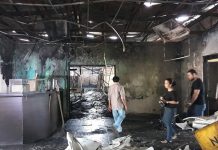

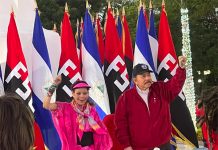


Hi Jeffrey – This one is very good: Perry, John. “Nicaraguans in Costa Rica: A Manufactured “Refugee” Crisis.” Council on Hemispheric Affairs, 23 March 2020. https://www.coha.org/nicaraguans-in-costa-rica-a-manufactured-refugee-crisis/
Thank you very much for sharing this article:
I just came across something very interesting. On July 1, 2021 a letter was sent to the Nicaraguan Government which was signed by 504 people. I did not recognize any of the names of the people who signed the letter except for two, Daniel Elsberg and Noam Chomsky. Here is a portion of the letter:
We are well aware of – and detest – the long, shameful history of U.S. government
intervention in Nicaragua and many other countries in Latin America.
However, the crimes of the U.S. government – past and present – are not the cause of, nor
do they justify or excuse, the crimes against humanity committed by the current regime of
Daniel Ortega and Rosario Murillo.
Over the last decade and a half, we have been increasingly disheartened to see how Daniel
Ortega and Rosario Murillo have consolidated an autocratic family dynasty bent on staying
in power above all else. We have been appalled by the targeting of women’s organizations,
independent journalists, and environmentalists and indigenous communities opposing
construction of the proposed canal. Controlling all branches of government, we have seen
how the regime has totally politicized public institutions and undermined the rule of law.
In 2018, we watched the massive “autoconvocado” social protests that erupted. We saw
hundreds of thousands of Nicaraguans take to the streets. This massive outpouring was not
– and could not be – the result of U.S. intervention. It was a demonstration of selfdetermination, of Nicaraguans thinking for themselves and taking action on their own
behalf.
We were shocked and horrified by the Ortega-Murillo regime’s deadly response to those
protests, and to the ever-escalating political repression of civil society and violation of the
Nicaraguan people’s basic human and constitutional rights.
And now, during these last few weeks and days, we are outraged by the latest maneuvers to
shut down all dissent. We are outraged by the arrest and detention of five prominent
potential opposition candidates in the scheduled November 2021 elections, even if we do
not agree with their political positions. We are outraged by the arrest and detention of civil
society and opposition activists and leaders. And we are outraged by the arrest and
detention of historic revolutionaries Dora María Téllez, Hugo Torres and Victor Hugo
Tinoco.
Thanks Jeffrey. I thought perhaps the drop in migration north was because people were going back to Costa Rica. But it looks like not yet – the figures show pretty much the same number of Nicaraguans returning to Nicaragua as going to Costa Rica, like in 2020, 2021 and 2022. Once Cost Rica’s economy picks up I’m sure Nicaraguans will be going there for work like they have for at least 50 years. Although now that Nicaragua’s health and education are better, people return to Nicaragua for operations, or stay if they are studying or if a child is studying. Because of hundreds of thousands of Nicaraguans who have worked over the years in Costa Rica you have that group of people simply taking advantage of the situation to say that they need asylum with the hope of getting residency status. But very few do, because very few of the asylum cases are real. But if you could talk to each one of those 205,000 asylum seekers you would find that over 95% have worked for years in Costa Rica!!
Remember – there is this historic work relationship where the majority of Nicaraguans who leave for work, go to Costa Rica, because it is close and easy to get back home in the case of an emergency.
Thank you for your feedback. Here is some additional information that can provide some added knowledge:
https://nacla.org/nicaraguan-migrants-face-uncertainty-costa-rica
This is a very informative article.
By the way there is also a large population of asylum seekers going to Costa Rica
Following age-old migration patterns, the bulk of Nicaraguans have gone to neighboring Costa Rica, which is experiencing a record level of humanitarian migration. Nicaraguans sought asylum in Costa Rica just 67 times in 2017, but numbers increased dramatically to 23,000 in 2018 and continued to rise precipitously. As of June 2022, Costa Rica hosted 205,000 asylum seekers—89 percent of them from Nicaragua—in addition to 11,000 refugees. Despite Costa Rica’s modest population, the country received the fourth largest number of asylum applications globally in 2021, behind only the United States, Germany, and Mexico, according to UNHCR